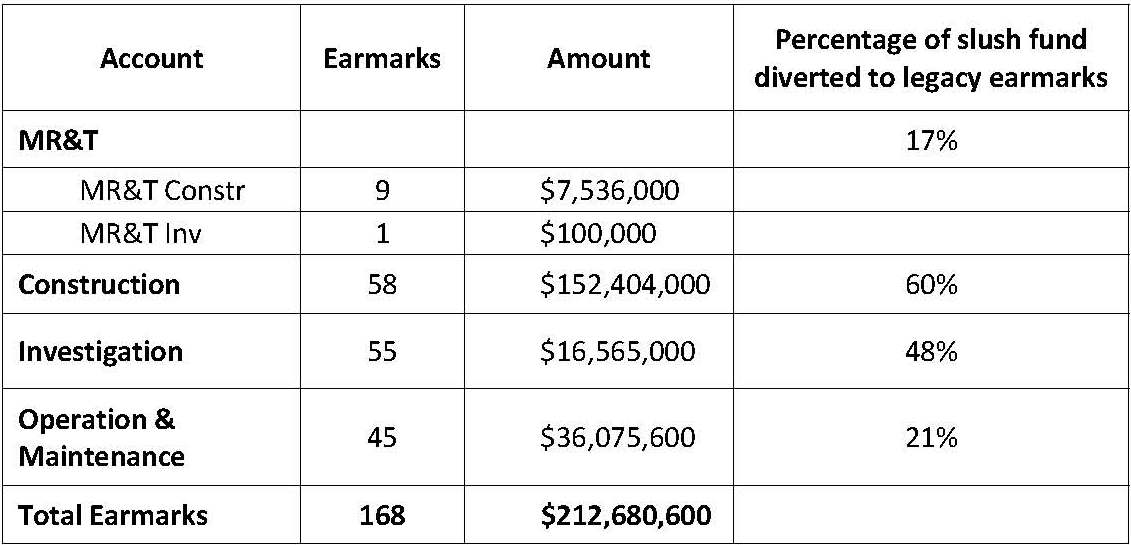View/Download this article in PDF format.
(February 8, 2012
3:00 p.m.)
Below is a chart detailing the number of projects that receive funding in the Corps 2012 Work Plan that were not funded in the President’s budget request and also were not listed in the joint explanatory statement that accompanied the Energy and Water Appropriations bill. Many of these were previously wasteful earmarks that we have highlighted, like $16.9 million for the economically challenged Delaware River deepening project, and the millions for so-called Environmental Infrastructure projects that have been opposed by the Clinton, Bush, and up until now, Obama Administrations.

(February 8, 2012
11:00 a.m.)
The United States Army Corps of Engineers has published its FY2012 work plan. There are numerous legacy earmark projects receiving funding that were not included in the President’s budget request, like the Delaware River Deepening that’s receiving in excess of $16 million in construction funding, dubious environmental infrastructure projects, and more.
We have just started digging through this work plan, but at first glance it appears the Administration has not heeded the warning TCS and a number of other groups sent to OMB and the Corps in a letter last week:
These “slush” funds must not simply be used to fund projects that were not good enough to make it into the President’s budget. Otherwise, the Administration will be complicit in helping lawmakers obtain earmarks through the back door while Congress claims a moratorium is in place.
We will have more analysis, but you can access the PDF files for yourself at the following links:
- 2012 Work Plan–Construction
- 2012 Work Plan–Investigations
- 2012 Work Plan–Mississippi River and Tributaries
- 2012 Work Plan–Operation & Maintenance
—-
(Originally posted January 12, 2012)
The U.S. Army Corps of Engineers’ budget is formulated project by project. In FY 2010 (the last year the Corps operated under a regular spending bill, not an extension of the previous year’s funding aka a continuing resolution), their civil works budget included 1,738 different projects worth roughly $4.6 billion. That represented a slight increase in total funding from the President’s budget request of $4.5 billion in this area (1,109 projects). But in reality, Congress added far more earmarked projects (629 worth $533.6 million) than increased total funding (about $100 million). In other words, they added a substantial number of project mouth to feed, without giving the agency much more in the way of resources. Just about every project in the President’s budget request was “taxed” some amount to fund Congressional earmarks.
Due to the earmark moratorium, there aren’t earmarks in the FY 2012 Corps budget. At least not yet. In an effort to make their mark on the Corps budget, Congress included 26 different slush-y funds – totaling $507 million – for the Corps to spend on a variety of investigations, construction, and operations and maintenance projects that weren’t funded in the budget or the final spending bill. Congress does stipulate certain criteria for these projects and instructs the Corps to report back within 45 days about how they intend to spend the new cash. Provided below is a table breaking down all the slush-y funds.
Slushy Funds Contained in Energy and Water Portion of FY2012 Omnibus Bill
|
<stronginvestigations< strong=””></stronginvestigations<> |
Construction |
MR&T |
O&M |
Total |
|
| General Flood & Storm Damage Reduction |
$2,000 |
$19,722 |
$21,772 |
||
| Dredging (MR&T only) |
$5,000 |
$5,000 |
|||
| Flood Control |
$9,000 |
$59,316 |
$24,000 |
$92,316 |
|
| Shore Protection |
$3,000 |
$39,544 |
$42,544 |
||
| General Navigation |
$2,000 |
$74,145 |
$34,000 |
$110,145 |
|
| Coastal & Deep-Draft Navigation |
$10,000 |
$55,000 |
$65,000 |
||
| Inland Navigation |
$3,000 |
$30,000 |
$33,000 |
||
| Small, Remote, or Subsistence Navigation |
$1,500 |
$30,000 |
$31,500 |
||
| Other Authorized Project Purposes |
$1,240 |
$7,909 |
$17,037 |
$24,409 |
$50,595 |
| Environmental Restoration or Compliance (other) |
$1,000 |
$8,897 |
$9,897 |
||
| Environmental Infrastructure (other) |
$29,660 |
$29,660 |
|||
| Hydropower (other) |
$13,840 |
$13,840 |
|||
| Remote, Coastal or Small Watershed (other) |
$2,000 |
$2,000 |
|||
| TOTALS | $34,740 | $253,083 | $46,037 | $173,409 | $507,269 |
Category Totals, Compared to Amounts Requested
by Administration, House, & Senate
|
Request |
House |
Senate |
Conference |
Conference Increase Over Request |
Conference Increase Over House |
Conference Increase Over Senate |
||
| Investigations |
$104,450 |
$104,000 |
$125,000 |
$125,000 |
$20,550 |
$21,000 |
$0 |
|
| Construction |
$1,480,000 |
$1,565,191 |
$1,610,000 |
$1,694,000 |
$214,000 |
$128,809 |
$84,000 |
|
| MR&T |
$210,000 |
$210,000 |
$250,000 |
$252,000 |
$42,000 |
$42,000 |
$2,000 |
|
| O&M |
$2,314,000 |
$2,368,925 |
$2,360,000 |
$2,412,000 |
$98,000 |
$43,075 |
$52,000 |
|
| TOTALS |
$4,108,450 |
$4,248,116 |
$4,345,000 |
$4,483,000 |
$374,550 |
$234,884 |
$138,000 |
Note: All numbers are in 1,000s
A couple of interesting points:
- Similar to the earmarking hijinks of yesteryear, Congress came up with the slush-y fund money in significant measure by pillaging projects that were already in the budget. While Congress set aside $507 million in these funds, they only increased the agency budget $375 million versus the President’s request.
- The $507 million in these 26 funds is eerily similar to the $533.6 million worth of Congressional earmarks in the Corps’ FY10 budget.
- Unlike the majority of the federal budget’s discretionary programs, in three of the Corps’ four main funding areas (Construction, Operation & Maintenance, and Mississippi River & Tributaries) not only got a boost of the funding levels in the President’s budget, but actually received more money in conference than in either the House or Senate version of the FY12 spending bills. When it comes to Congress and the Corps, they split the difference by adding more cash. (General Investigations received the higher Senate spending level).
- Congress provided $29 million in a slush-y fund for Environmental Infrastructure. These type of “projects” (water supply and wastewater treatment) were opposed by the Clinton, Bush, and Obama administrations as duplicative of EPA programs and being little more than politically driven cash cows for projects outside the Corps mission area.
TCS will be anxiously waiting to see what the Corps comes up with to fund. There will most definitely be a flurry of letters and calls from lawmakers trying to get the slush-y fund cash wasted on their pet project. One of the dangers of this system (and why a truly transparent merit-based approach has to be adopted) is that, unlike in the past where a lawmaker could offer amendments trying to strike or limit funding for this or that harmful project, now boosters can work with the Corps to get boondoggles funded through these slush-y funds; All without the watchful eye of C-Span cameras and public oversight.
Here are the criteria Congress included in the Joint Explanatory Statement accompanying the final spending bill directing the Administration to consider for prioritizing allocations of the construction funds (other funding areas are similar):
“Number of jobs created directly by the funded activity; the benefits of the funded work to the national economy; ability to obligate the funds allocated within the fiscal year, including consideration of the ability of the non-federal sponsor to provide any required cost-share; ability to complete the project, separable element, or project phase within the funds allocated; for flood and storm damage reduction, population at risk and economic activity or public infrastructure at risk; and for navigation, number of jobs or level of economic activity to be supported by completion of the project, separable element, or project phase.”
In addition: “A document detailing the Administration’s specific criteria and project evaluations used to justify the funding decisions shall accompany this work plan. No funds shall be obligated for any project under this program which has not been justified in such a report.”
While we believed the earmark moratorium might make our job of tracking federal spending a little easier, Congress strike us as being determined to make it harder. Look for more from TCS as we continue to dig into the new bestseller – the Omnibus.










